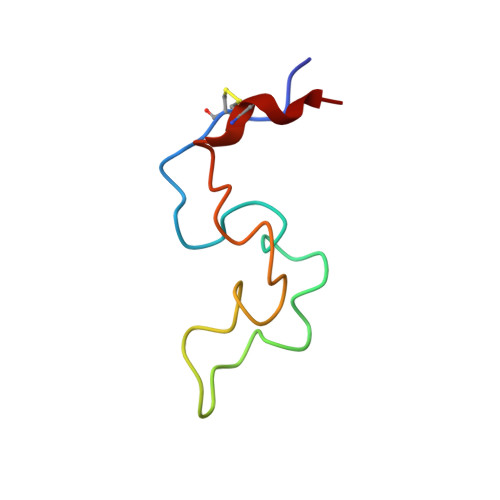Ebolavirus Entry Requires a Compact Hydrophobic Fist at the Tip of the Fusion Loop.
Gregory, S.M., Larsson, P., Nelson, E.A., Kasson, P.M., White, J.M., Tamm, L.K.(2014) J Virol 88: 6636-6649
- PubMed: 24696482
- DOI: https://doi.org/10.1128/JVI.00396-14
- Primary Citation of Related Structures:
2M5F, 2MB1 - PubMed Abstract:
Ebolavirus is an enveloped virus causing severe hemorrhagic fever. Its surface glycoproteins undergo proteolytic cleavage and rearrangements to permit membrane fusion and cell entry. Here we focus on the glycoprotein's internal fusion loop (FL), critical for low-pH-triggered fusion in the endosome. Alanine mutations at L529 and I544 and particularly the L529 I544 double mutation compromised viral entry and fusion. The nuclear magnetic resonance (NMR) structures of the I544A and L529A I544A mutants in lipid environments showed significant disruption of a three-residue scaffold that is required for the formation of a consolidated fusogenic hydrophobic surface at the tip of the FL. Biophysical experiments and molecular simulation revealed the position of the wild-type (WT) FL in membranes and showed the inability of the inactive double mutant to reach this position. Consolidation of hydrophobic residues at the tip of FLs may be a common requirement for internal FLs of class I, II, and III fusion proteins. Many class I, II, and III viral fusion proteins bear fusion loops for target membrane insertion and fusion. We determined structures of the Ebolavirus fusion loop and found residues critical for forming a consolidated hydrophobic surface, membrane insertion, and viral entry.
Organizational Affiliation:
Center for Membrane Biology and Department of Molecular Physiology and Biological Physics, University of Virginia, Charlottesville, Virginia, USA.














